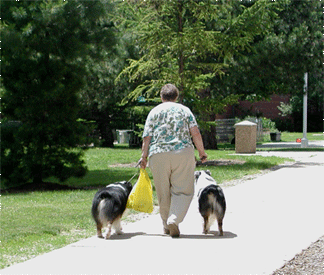Victor Margolin
The changing nature of public space is becoming a growing issue in American culture. The efflorescence of new technologies – the laptop, the iPod, the cellphone – have made it possible to isolate one’s self from others in the public sphere.
Cafes, for example, are now used as much like library reading rooms as they are places to meet and talk with others. The shift from public places where people meet to spaces where they pursue their personal projects is also becoming evident in the design of parks. A while back, the Chicago Tribune had an interesting article about the new demands that people are making on the city’s park system. Basketball courts, baseball diamonds, and tennis courts are out and tranquil landscaped spaces, jogging paths, skateboard parks, batting cages, and dog parks are in. While it may seem normal to adopt new pastimes and leave old ones behind, the actual pattern here is a shift from community sports to more individually gratifying pastimes. The continued demand for soccer fields is the exception but, as the article points out, it comes from Chicago’s Hispanic population whose interest in team sports originates elsewhere.

Middle class Americans have developed a preference for activities that enhance their own fitness, prowess, or pleasure. What all of these activities have in common, whether jogging, skate boarding, or walking their innumerable dogs, is that they do not require interaction with others. They can be controlled and pursued alone, although chatting may occur on the jogging track or on a park bench. However, it is not integral to the activity and can be cut off if the conversation becomes unsatisfying. Compare this with the sand lots and playgrounds that people of my generation, those in their 50s and 60s, grew up with. When I was a boy in Washington D.C., I lived on a street with an empty lot that was a mecca for all the kids on the block and in the neighborhood. Eventually a developer built an apartment house on that lot but for the years that I lived next to it, the lot was empty. We had pick up baseball games in the summer and snowball battles in the winter. Sometimes the going got a little rough. There were bullies and fights but also lots of camaraderie with peers. We played together without anyone controlling who could join the game. Besides this empty lot, I would ride my bike after school to a baseball field about a mile away where everyday there would be pickup baseball games and as I grew older, after my family moved to the other side of Rock Creek Park, I would go regularly to one of several nearby basketball courts to shoot baskets, whether a game happened or not.
Group sports, and particularly pick up games, leave us vulnerable but also challenge us. We may be outclassed but we can measure out abilities against the skills of others. We can learn to communicate with people we hardly know around shared objectives of shooting baskets or swatting baseballs. This creates community and makes public space truly public. But it also means giving up total control of our environment and our social world. Sadly the trend is towards more control rather than less. People walk the streets plugged in to their iPods or chattering on their cell phones. They handle much of their personal business on-line and reduce the number of encounters with tradesmen, bank tellers, and other service providers. Now this is spilling over into the design of public space. The new parks with their beautiful landscaping, doggy decks, and batting cages may appear idyllic but they are deceptively isolating. Those who have never played pick up sports will not understand the feeling of community that comes from a shared activity with a group of other people, whether one knows them well or not. Today, I walk the streets of Chicago, willing to talk with anyone who looks interesting or friendly. I can’t say that I owe this openness to the pick up games in my old neighborhood but I can’t say that I don’t.
Victor Margolin is Professor Emeritus of Design History in the Department of Art History of the University of Illinois at Chicago, and a founding editor of DesignIssues.










